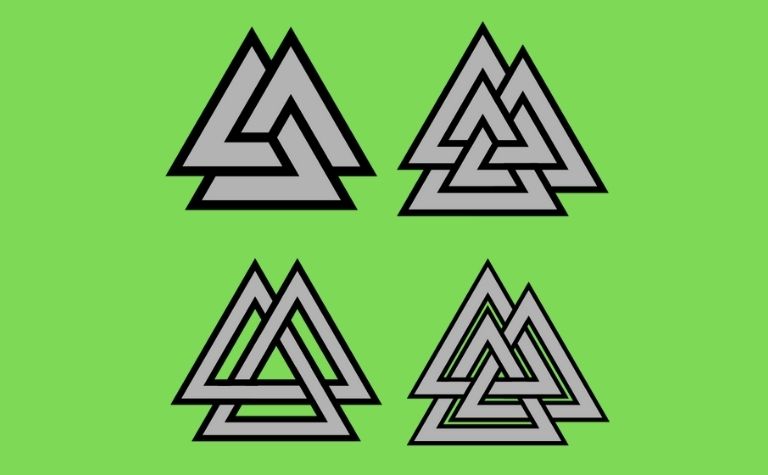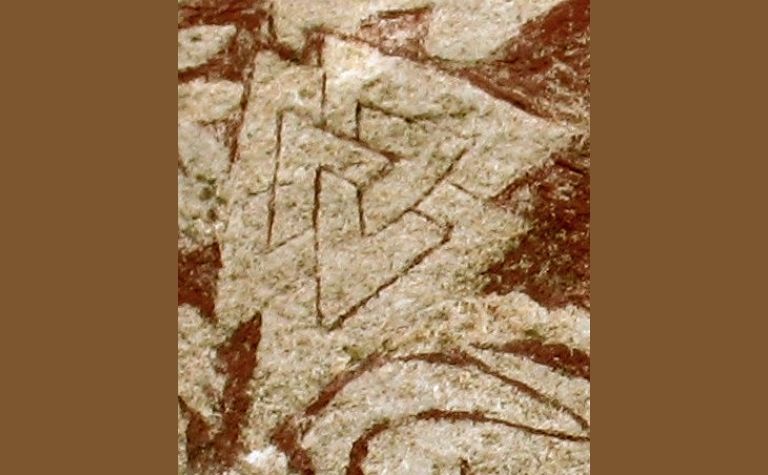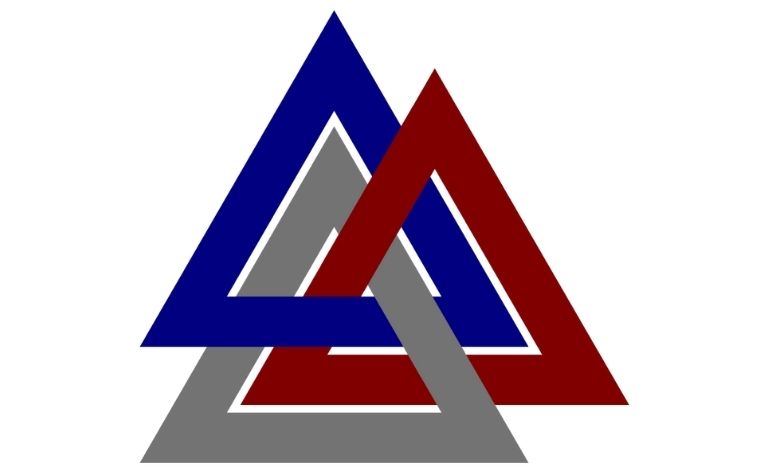Although many people don’t know the valknut symbol by name, it’s widely recognized, even among those who don’t enjoy studying or reading about Norse mythology.
Pronounced “valk (or volk) noot,” the valknut symbol is depicted as three interlocked triangles, but what does it represent? And where did it originate?
Most people associate the valknut with Odin or death, possibly sacrifice. The word valknut never appears in Viking-era literature.
However, a story in the Prose Edda describes Hrungnir’s heart as looking like a valknut. It also appears in a few artifacts remaining from the era.
This article will explore what people think the meaning of the valknut is, why so many get tattoos of the symbol, and whether or not it is controversial. (Unfortunately, it is.)
Also see The Meaning of Odin’s Horn Symbol to learn more.

What Is the Meaning of the Valknut Symbol?
Today, people who want to see the valknut can view it on various artifacts in Scandinavian museums, including:
- The Oseberg Ship (carved into a bed and on a surviving tapestry) [1]
- The Tängelgårda Stone
- The Stora Hammars Stones
- The Nene River Ring
Unfortunately, being able to see it doesn’t necessarily equate to understanding it.
There’s no single, uncontested meaning of the valknut symbol.
The word valknut means “knots of those fallen in battle.”
However, people have different opinions about what the symbol itself means.
One of the most common interpretations is that it symbolizes the transition between life and death.
Another common association with the valknut is the god Odin. Some people think of it as his symbol.
Still, others take the analogy further and claim it represents a sacrifice to Odin. Other accepted meanings of the valknut include:
- Hrungnir’s heart
- A warrior’s death/Valkyries
- Magic
- Reincarnation [2]
The following sections will look at each of these different associations of the symbol as a whole.
They’ll also discuss a common opinion among scholars on what the symbol’s various aspects mean individually.
Also see Who is Ymir in Norse Mythology? to learn more.
The Transition Between Life and Death & Odin
These two things go hand-in-hand and are the most commonly accepted meanings of the valknut symbol, sometimes called “Odin’s knot.”
As mentioned earlier, the word valknut doesn’t appear in any Norse or Viking literature.
However, scholars have found it on surviving artifacts.
The symbols often appeared on burial mounds and stones found inside or near burial mounds.
That’s why so many, though not all, scholars agree that the valknut symbolizes the transition between life and death.
Since one of Odin’s powers includes guiding people through that transition, the symbol also gets equated with the All-father.
A Warrior’s Death/Valkyries
Those who believe the valknut symbolizes the transition between life and death often ascribe it specifically to a warrior’s death.
In Norse mythology, Odin only chose the most fierce warriors to go with him to Valhalla, and he sent his valkyries to retrieve them.
Therefore, any death associated with Odin would’ve been a warrior’s death.
Also see What Is Odinsleep? to learn more.

Sacrifice, Specifically to Odin
The justification for this meaning of the valknut comes primarily from the Stora Hammar stones. [3]
One of the images carved into the stone shows a sacrifice to Odin.
A figure lies on a table near another figure with a spear.
The spear-wielding figure may be cutting a Blood Eagle into the sacrificed figure’s back. Above the dying man is a large carving of the valknut.
Hrungnir’s Heart
Hrungnir was a giant who Thor defeated in the Prose Edda’s “Skáldskaparmál.”
The heart’s description is as follows: “Hrungnir had the heart which is notorious, of hard stone and spiked with three corners, even as the written character is since formed, which men call Hrungnir’s Heart.” [4]
As a result, some people think that’s the real meaning behind the valknut.
However, most artifacts featuring it also feature Odin, not Hrungnir.
Therefore, most serious Norse mythology and Viking scholars discount this meaning out of hand.
Magic and Reincarnation
These last two “meanings” of the valknut aren’t widely accepted.
However, some people stand behind them.
Though not as well known for his magical abilities as Loki, Odin was magical.
He practiced a form of magic called Seidr. Many people think the valknut represents magical spells cast by Odin.
Additionally, a valknut carved into an ax or shield would “magically” protect the bearer.
Others assume the three triangles in the valknut represent:
- Fertility
- Rebirth
- Reincarnation [5]
Therefore, a valknut on a burial stone could be a magical symbol that would lead the deceased back into a new life.
The Valknut’s Construction
The valknut looks slightly different in many of the images in which it appears. Historians break these differences down into two distinct valknut styles:
- The unicursal valknut
- The tricursal valknut
The unicursal valknut is one cohesive symbol with no breaks.
If someone were to draw it on paper, they’d never lift their pen. However, the tricursal valknut is three distinct triangles combined.
Either way, most people agree on what they think the symbol’s individual aspects represent. [6]
They attribute the nine triangle points to the nine worlds in Norse mythology.
The three triangles are the three most famous worlds: Asgard, Midgard, and Niflheim (Hel). (Others call it Heaven, Earth, and Hell.)
Also see Does Loki Have Horns In Norse Mythology? to learn more.

Why Do People Get Tattoos of the Valknut Symbol?
People get tattoos of the valknut for different reasons. Some do so in honor of a deceased friend, loved one, or fellow soldier.
Others insist it represents reincarnation. Still, others proudly display the tattooed symbol as a sign of their Viking heritage or belief in the Norse gods (Asatru).
As is always the case with tattoos, each person has their reasons.
Those are some of the most common, though. Unfortunately, some people have co-opted the beautiful symbol to mark them as members of hate groups.
Is the Valknut Symbol Controversial?
Though it wasn’t always, the valknut symbol is controversial today.
Recently, neo-Nazis and white supremacist groups have begun to use many ancient Norse symbols, including the valknut, Thor’s hammer, and the raven flag of Odin, to represent their hateful affiliations.
Many Scandinavians have spoken openly about their anger and frustration at these groups for stealing symbols of their heritage and using them for such hostile reasons. [7]
That’s especially true of those who have reclaimed the old beliefs of Asatru and heathenism.
Hate is not a part of the Viking culture or the Asatru faith.
The valknut and other symbols are just outward extensions of their beliefs to members of these communities.
Unfortunately, when someone sees a person sporting a valknut today, it’s impossible to know whether they are a peaceful heathen or a violent neo-Nazi.
Conclusion
The valknut is one Viking-age symbol whose meaning and history are still shrouded in mystery. That doesn’t make it any less popular today.
Also see Can Ragnarok Be Stopped in Norse Mythology? to learn more.
References:
[1] Source
[2] Source
[3] Source
[4] Source
[5] Source
[6] Source
[7] Source
